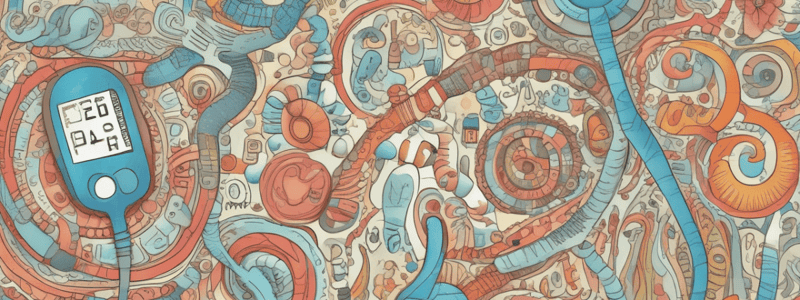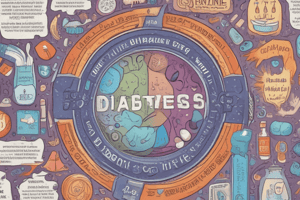Podcast
Questions and Answers
What is the main difference between type 1 and type 2 diabetes in terms of insulin?
What is the main difference between type 1 and type 2 diabetes in terms of insulin?
- Type 1 has insulin resistance, while type 2 has no insulin
- Type 1 has low insulin levels, while type 2 has high insulin levels
- Type 1 has high insulin levels, while type 2 has low insulin levels
- Type 1 has no insulin, while type 2 has insulin resistance (correct)
What is a common complication of diabetes that can lead to blindness?
What is a common complication of diabetes that can lead to blindness?
- Neuropathy
- Retinopathy (correct)
- Microangiopathy
- Nephropathy
What is the main mechanism that limits muscle protein breakdown in starvation, but not in diabetes?
What is the main mechanism that limits muscle protein breakdown in starvation, but not in diabetes?
- KB production
- Glucagon release
- Insulin release (correct)
- FA release from adipocytes
What is a characteristic of type 2 diabetes in terms of ketoacidosis?
What is a characteristic of type 2 diabetes in terms of ketoacidosis?
What is the primary treatment for type 1 diabetes?
What is the primary treatment for type 1 diabetes?
What is a common association of type 2 diabetes?
What is a common association of type 2 diabetes?
What is the total energy value in kcal of glycogen present in the muscle and liver?
What is the total energy value in kcal of glycogen present in the muscle and liver?
In the fasting state, what is the primary source of energy?
In the fasting state, what is the primary source of energy?
What is the concentration of blood glucose maintained by the liver in the fasting state?
What is the concentration of blood glucose maintained by the liver in the fasting state?
What is the source of blood glucose after 24 hours of fasting?
What is the source of blood glucose after 24 hours of fasting?
What is the reaction catalyzed by Pyruvate dehydrogenase (PDH)?
What is the reaction catalyzed by Pyruvate dehydrogenase (PDH)?
What is the effect of insulin on Pyruvate dehydrogenase (PDH)?
What is the effect of insulin on Pyruvate dehydrogenase (PDH)?
What is the fate of excess acetyl-CoA in the fed state?
What is the fate of excess acetyl-CoA in the fed state?
What is the primary function of hormone sensitive lipase in adipose tissue?
What is the primary function of hormone sensitive lipase in adipose tissue?
What happens to gluconeogenic substrates when FA is used as fuel by liver adipose tissue and muscle?
What happens to gluconeogenic substrates when FA is used as fuel by liver adipose tissue and muscle?
What is the result of FA oxidation in the hepatocyte?
What is the result of FA oxidation in the hepatocyte?
What happens to body protein in prolonged starvation?
What happens to body protein in prolonged starvation?
What is the fate of ketone bodies in prolonged starvation?
What is the fate of ketone bodies in prolonged starvation?
What is the effect of ketone bodies on the pancreas?
What is the effect of ketone bodies on the pancreas?
What is the outcome of diabetes mellitus?
What is the outcome of diabetes mellitus?
What is the characteristic of Type 1 diabetes?
What is the characteristic of Type 1 diabetes?
What is the hallmark of diabetes type 1?
What is the hallmark of diabetes type 1?
Study Notes
Diabetes Type 2
- Usually has a later onset
- Characterized by insulin resistance, where target tissues are non-responsive
- Typically milder than Type 1 diabetes
- Associated with diet and lifestyle, particularly obesity
- Incidence is increasing, including in children
Characteristics of Diabetes
- Hyperglycaemia, but usually no ketoacidosis
- Often responds to diet and oral hypoglycaemic agents
Metabolic Pattern in Uncontrolled Diabetes Mellitus
- Resembles that of starvation, but more exaggerated
- Insulin is low in starvation, absent in Type 1 diabetes
- Glucagon acts unopposed, leading to uncontrolled production of ketone bodies
- This important mechanism does not operate in diabetes
Chronic Complications of Diabetes Mellitus
- Microangiopathy: changes in small blood vessels, seen as thickening of basement membrane
- Retinopathy: blindness is 25 times more common in diabetic patients
- Nephropathy: renal failure is 17 times more common
- Neuropathy: postural hypotension, impotence, foot ulcers
Treatment of Diabetes
- Type 1: exogenous insulin by injection
Total Fuel Reserves in the Average Man
- Glycogen: 300g in muscle, 80g in liver, 15g in body fluids
- TAG: 15kg in adipose tissue
- Protein: 6kg in muscle
- Total energy reserve: 697.8MJ
The Fasting (Post-Absorptive) State
- Blood glucose concentrations peak an hour after eating and return to normal by two hours after a meal
- Blood glucose is removed for oxidation or storage
- Concentration of insulin drops and glucagon rises
Metabolism in the Fasting State
- Liver maintains blood glucose concentrations at about 4mM
- Adipose tissue provides the greatest source of energy as TAGs
- Hormone-sensitive lipase is activated by glucagon and adrenaline
- FA are transported to the liver bound to albumin
Glucose Production by the Liver
- The first supplier of blood glucose is liver glycogen
- Gluconeogenesis follows from lactate, glycerol, and amino acids
- After 24 hours of fasting, all blood glucose comes from gluconeogenesis
Fatty Acid Metabolism
- Fatty acids are not gluconeogenic precursors
- The reaction catalyzed by Pyruvate dehydrogenase is irreversible
- PDH is activated by insulin and inhibited by glucagon
Ketone Body Formation
- FA oxidation in the hepatocyte leads to high concentrations of Acetyl CoA
- Acetyl CoA is channelled into ketone body formation
- Acetoacetate and β-hydroxybutyrate are released into the bloodstream
Prolonged Fasting (Starvation)
- If the early pattern were to continue, body protein would be severely depleted
- Only about a third of body protein can be lost without severe or fatal consequences
Studying That Suits You
Use AI to generate personalized quizzes and flashcards to suit your learning preferences.
Description
This quiz covers the characteristics of diabetes type 2, including its onset, symptoms, and treatment options. Learn about insulin resistance, associations with diet and lifestyle, and the metabolic pattern in uncontrolled diabetes.




